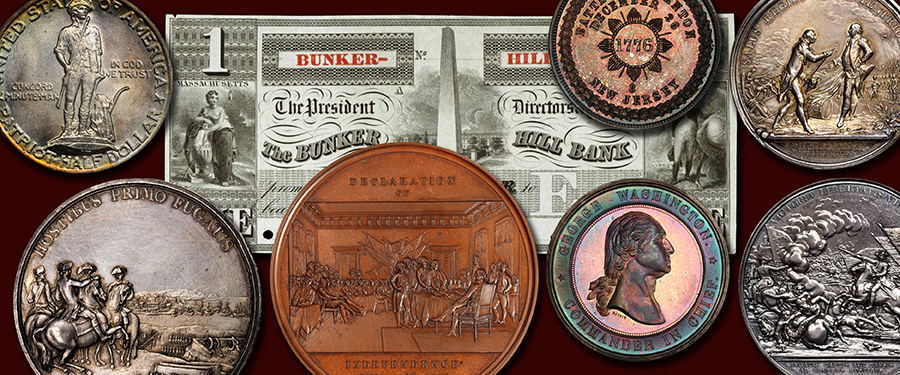
Independence Day is upon us once again. In this week’s blog,
we are going to take a look at a few major battles of the Revolutionary War and
the medals, currency and coins that commemorate them.
1.
Lexington and Concord – Famous for the “Shot
heard around the World,” this Revolutionary battle was the first American
victory. It pitted the American Minutemen against a very experienced British
Army. The 1925
Lexington-Concord Sesquicentennial features a Minuteman on the obverse and
the Old Belfry on the reverse. Old Belfry’s bell was rung on the morning of
April 19, 1775, to alert the Minutemen that it was time to assemble for battle.
As they say, the rest is history.
2.
Siege of Boston – Following the battles at
Lexington and Concord, the Continental Army was formed. They saw their first
action in the month-long siege on Boston. The Continental Army sought to
contain the British to the city of Boston and force their surrender. After the
standoff, the British retreated to Halifax, Canada. The “1776”
Washington Before Boston silver medal shows the seven British ships making
their departure from the bay surrounding Boston. This retreat was a key victory
for Washington and his troops.
3.
On July 2, 1776, the Continental Congress approved
the Declaration of Independence. Two days later, on July 4, 1776, it was
adopted and signed by the Congress. It listed the reasons for separation from
the British homeland. The famous signing of the Declaration scene is
beautifully displayed on the reverse of the “1776”
Charles Cushing Wright bronze medal.
4.
The Battle of Bunker Hill was one of the first
official battles of the American Revolution. Colonial forces captured Bunker
Hill and withstood multiple attacks from the British. However, they ran out of
ammunition and lost the third and final battle. While the Colonials lost the
battle, the British lost a significant number of troops limiting their
effectiveness going forward. The Bunker Hill Bank paper
money shows the monument erected in commemoration of the battle. This note
was produced by the New England Bank Note Co.
5.
Several battles were fought between Bunker Hill
and the Battle of Trenton, but this Christmas 1776 battle was key in the
American Revolution. This battle was a very important morale boost for the beat
up and knocked down American forces. You may know this battle from the famous
scene of Washington crossing the Delaware River. The 1876
George Lovett’s Battle Series Number 8 medal commemorates this important
victory. This So-Called dollar is shown in silver.
6.
The Battle of Saratoga is considered the turning
point of the revolution. In 1777, American soldiers surrounded the British
forces in Saratoga, New York, cutting them off from escape. It was during this
battle that foreign forces began to recognize the colonies as independent and gave
their support to the American cause. The scene on the reverse of the 1777
Saratoga silver medal is powerful. It depicts the British General Burgoyne
presenting his sword to General Horatio Gates. On the left of the medal, the
British troops kneel and lay down their weapons. On the right side of the
medal, the American troops stand at attention.
7.
During the winter of 1777-1778, Washington and
his troops camped at Valley Forge. They suffered from starvation and disease as
they waited out the winter months. However, Washington was able to keep the
support of his troops on the promise that the French were sending
reinforcements to support the American cause. After a long, hard winter, the
troops retook Philadelphia from the British. This 1878
Valley Forge Centennial medal in silver commemorates the departure from
Valley Forge after the difficult winter.
8.
The end of the war was near when the Battle of
Cowpens, South Carolina took place. The American troops won South Carolina back
from the control of the British army, setting in motion events that led to
American victory and the end of the war. The back of this powerful medal shows Daniel Morgan
leading his infantry on horseback while pushing the British army away. On the
front, we see an Indian female (an allegorical figure representing America)
crowning Morgan, symbolic of the victory won by America.





